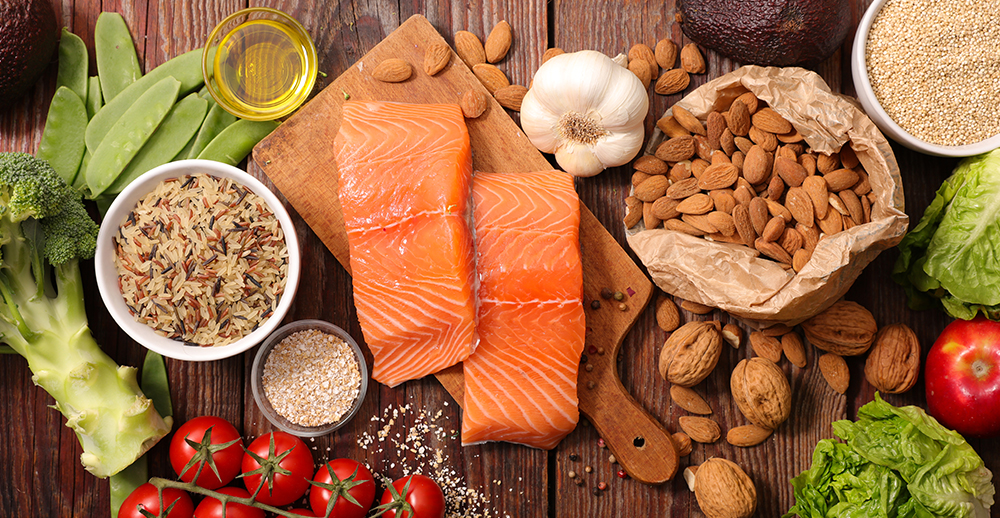
A ketogenic diet is an extreme nutritional intervention based on very low carbohydrate intake designed to mimic starvation and drive the body into ketosis- in which the body shifts from using glucose as it’s main fuel to using fat. While other low carb diets like the Atkins and Paleo diets have also focused on carb restriction, the ketogenic diet is far more than the latest fad diet but rather one supported by strong research to improve health, energy, brain function, and weight loss.
Although the ketogenic diet (KD) has been studied extensively for weight loss, promising research has shown a wide range of benefits in neurodegnerative diseases like Parkinson’s and Alzeheimer’s disease. Promising research has shown that ketones may be neuroprotective reducing the risk of cognitive decline while boosting memory, energy and mood. The KD provides antioxidant benefits that yield promise in treating cancer, and, in animal models, has been shown to confer longevity.
The Science of the KD
The goal of the ketogenic diet is to shift the body and brain to preferentially use ketone bodies formed by the mobilization of fat tissue as its fuel source instead of glucose. Ketone bodies such as acetoacetate and b-hydroxybutyrate (BHB) are formed by the body through ketogenesis and can be oxidized as a preferred energy source when energy is sparse as with fasting or high-intensity or prolonged endurance exercise. After 3 to 4 days of fasting, the mobilization of ketone bodies from fat stores produces the state of ketosis which can be a physiological response (with low glucose, low insulin) or can be pathological as in uncontrolled diabetes (with high glucose, low insulin). Ketogenesis is an evolutionary adaptation key to our survival in periods of famine to allow the body and brain to rely on an alternate fuel supply while preserving carbohydrate reserves in the liver and in working muscle as well as body protein stores.
KD and the Brain
The neuroprotective benefits of the ketogenic diet are well established. The brain accounts for only 2% of the body’s weight but 20% of its energy utilization. It preferentially uses glucose as its fuel but in the absence of glucose as with prolonged fasting, the brain can switch to burn ketones for energy. BHB can cross the blood brain barrier and have been shown to improve cellular energy in key brain areas involved in memory such as the hippocampus. BHB is not only an energy efficient fuel but can drive neurogenesis, the creation of new neurons as occurs in healing from traumatic brain injury or learning new skills. The ketogenic diet has been used as a nutritional intervention in children with epilepsy as ketones tilt the balance of brain excitation to more inhibition, conferring anti-seizure effects and neuroprotection.
KD in Weight Loss
The ketogenic diet has been used to achieve lasting weight loss. Beyond calories, the KD leads to more reliable weight loss than many other dietary interventions. When it comes to weight loss, it is likely that the KD exerts benefits in the following ways:
- Appetite control
An appetite suppressing effect of ketone bodies, especially BHB is thought to occur through an increase in the satiety hormones and indirectly due to the appetite suppressing effects of increased dietary protein. - Lipolysis
After prolonged fasting or carbohydrate restriction, there is a shift to utilize the body’s fat stores for energy production through ketogenesis in which ketone bodies are released to the blood stream. When ketosis is achieved, the lipolysis converts stored body fat into fuel. - Metabolic Efficiency
Ketones like BHB provide more energy per unit of oxygen consumed than glucose. The metabolic efficiency of a ketogenic diet can be demonstrated by a lowering of the respiratory quotient over time. - Thermogenic effects of Gluconeogenesis
Gluconeogenesis produces energy in the early phases of ketosis from protein sources but with a high metabolic cost of 400-600kcal/d. The metabolic “tax” or added caloric burn of the initiation phase of the KD is similar to the energy utilized by a lactating woman exclusively breast feeding her newborn.
While the KD holds promise in weight loss and brain health, to successfully implement the diet it requires a careful implementation strategy. Here are some best practices for a successful KD:
- Be brief
The KD works best for induction of weight loss and after as few as 3-4 weeks results may be achieved and then maintained with a less intensive regimen like the Mediterranean diet. Emerging research indicates that lasting and significant weight loss can be achieved with an induction ketogenic diet followed by a modified Mediterranean diet (MD) for maintenance. Beyond this timeline, remaining in ketosis should be done cautiously under medical supervision. - Dial up protein
While the traditional KD calls for no more than 25% of calories to be derived from carbohydrates and the balance largely from fat, a more practical modification is to dial up dietary protein, as well as fibre and low glycemic carbohydrates. - Try fasting intermittently
Physiologic ketosis can be achieved not only through major macronutrient shifts as in the KD but through caloric restriction. Intermittent fasting (IF) is a more acceptable mode of caloric restriction as it shifts the body into a fast induced ketosis intermittently. This can be achieved by fasting 12-15hrs on 3-4 days of the week. If on the non-fasting days a more strict ketogenic diet is followed, then the body is maintained in ketosis through the combination of IF and KD. - Enhance Ketosis exogenously
Dietary ketone supplements can help support a healthy ketosis and prevent the break down of healthy tissues. Pure beta-hydroxybutyrate (BHB) can be sourced as a functional food or nutritional supplement and consumed to enhance the health, weight and energy benefits of a ketogenic diet and lifestyle. - Intensify your work out
Like intermittent fasting, intense exercise can drive a physiologic ketosis and help to extend the ketogenic benefits of performing either IF and/or KD. High intensity exercise performed in intervals is referred to as HIIT. - Don’t go it alone
Before embarking on any form of extreme nutritional or lifestyle intervention, it is wise to perform a baseline medical assessment including testing of liver and kidney function and glucose metabolism. For most healthy individuals a modified KD as described above can likely be initiated safely but should be medically monitored.
There is no one right diet nor a cookie cutter solution to weight loss. Although the ketogenic diet may be extreme and hard to maintain, it can be an effective way to kick start your weight loss and boost your brain fitness.




